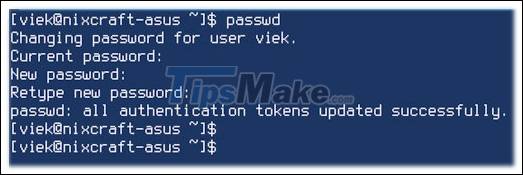How to set and change a user password in Linux
The passwd command changes the password for the user and group accounts. Ordinary users can only change the password for their own account, advanced users (or root) can change the password for any account. The administrator of a group can change the password for the group.
The passwd command also changes account information, such as the user's full name, the user's login shell, or the password expiration date and time.
Set user password in Linux
Enter the following passwd command to change your own password:
$ passwdSample outputs:
Changing password for vivek (current) UNIX password: Enter new UNIX password: Retype new UNIX password: passwd: password updated successfullyThe user is first prompted for his or her old password if available. This password is then encrypted and compared with the stored password. The user has only one chance to enter the correct password. Advanced users are allowed to skip this step in order to change the forgotten password. New passwords are checked for complexity. As a general rule of thumb, a password must consist of 10 to 20 characters that include one or more of the following conditions:
- Include lower case letters
- Include capital letters
- Digits 0 to 9
- Punctuation / space character
Change the password for another user account in Linux
You need to log in as the root user, enter the following command to change the password for the vivek user :
# passwd vivekOr:
$ sudo passwd vivekSample output:
Enter new UNIX password: Retype new UNIX password: passwd: password updated successfullyIn which, vivek is the username or account name.
Passwords do not appear on the screen when you enter them. For example:

Change the Linux group password
When the -g option is used, the password for the group will be changed. In this example, change the password for the sales group :
# passwd -g salesThe -r option is used with the -g option to remove the current password from the group. This gives the group access to all members. The -R option is used with the -g option to restrict the group to all users.
Change user password on Linux
As a Linux system administrator (sysadmin), you can change the password for any user on your server. To change the password on behalf of the user:
Step 1. First, log in or use 'su' or 'sudo' to access the 'root' account on Linux. Run the command:
sudo -iStep 2. Then type passwd tom to change the password for the tom user .
The system will prompt you to enter your password twice.
To change or set a new root (superuser) password:
$ sudo passwdForce Linux users to change their password the next time they log in
By default, Linux passwords never expire for a user. However, you can force the user to change their password the next time you log in via the GUI or CLI method. The syntax is very simple:
$ sudo passwd -e {username} $ sudo passwd --expire {username}For example:
$ sudo passwd -e marlenaThe system will confirm it:
passwd: password expiry information changed.When a user tries to log in via the ssh command, they should see the following on the screen:
$ ssh marlena@192.168.2.25 Last login: Fri Dec 4 04:12:48 2020 from 192.168.2.105 WARNING: Your password has expired. You must change your password now and login again! Changing password for marlena. Current password: New password: Retype new password: passwd: password updated successfully Connection to 192.168.2.25 closed.Lock and unlock your account's user password
Note that the following local commands do not disable the account. Users can still log in with another authentication code, such as the SSH key. To disable the account, the administrator should use the command usermod --expiredate 1 {username} or sudo passwd --expire {username} .
Additionally, users with a locked password are not allowed to change their password to comply with the privacy policy set by sysadmin.
You can lock the password as follows:
$ sudo passwd -l {username}This option disables the password by changing it into a value does not match the value can be encrypted (it adds mark! At the beginning of the password in the file / etc / shadow. To unlock password, to try on:
$ sudo passwd -u {username}The above command option re-enables the password by changing the password back to the previous value. In other words, return the value before using the -l option .
You should read it
- How to Change Root Password in Linux
- How to manage user passwords from Terminal in Linux
- 8 best Linux password managers
- How to Change the Root Password in Linux
- How to reset WSL user password
- How to change Apple ID password?
- How to change your computer, phone and Mac passwords
- 2 steps to change Linksys wifi password
- Instructions for changing Windows passwords without having to remember the old password
- How to change VNPT WiFi password
- What is Unix / Linux?
- Instructions for changing Viettel WiFi modem password
Maybe you are interested
How did 'LoveBug' change the world of malware? How to create a two-screen switch mode shortcut on Windows 10 4K quality theme for Windows 10 WiMax gigabit speed creates 4th generation mobile network The types of people who have money should not be connected, no money nor should they ask for a side 8 things you can do when you feel bored
